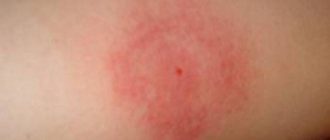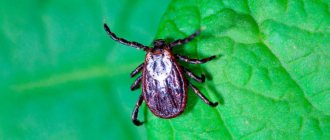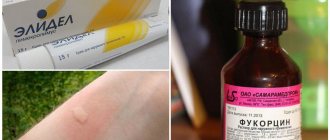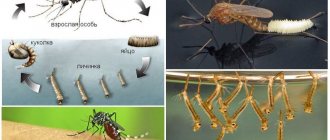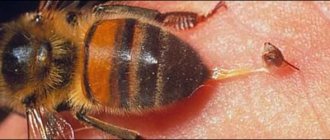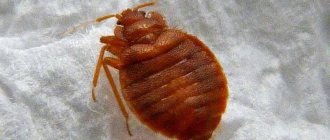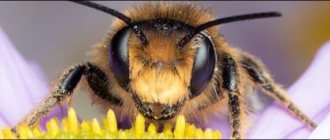Why do you need a sting?
The sting of a bee and wasp is part of the structure of their body.
wasp sting
The female wasp has a stinge, but the males do not have it.
The tip is designed as a protective device and a tool for capturing a large victim.
Adult wasps are vegetarians and use their stingers to search for and obtain food or for personal defense and home security.
Bee sting
A bee sting is an integral part of the insect's body; it is pointed. When a bee stings, a burning, poisonous substance gets under the skin. The puncture of the tissue occurs due to the movement of the bee's stinger: it protects it from captures and attacks.
Stinging process
Knowing the structure of a bee, you can observe how, in the process of contact with an enemy, the insect defends itself and, as they say, “bites.” Preparing to attack, the insect lowers and then arches its abdomen, exposing part of its stinging “tool.” After stinging, trying to fly away, the bee loses the sting; it simply comes off, since the barbs prevent it from leaving the body.
The sting is similar to two elongated stilettos, extended from the insect’s abdomen along special “channels”. When the bee is at rest, such formations at the end of its body are in a closed state: they are pushed apart by special plates at the moment of attack.
Where is the sting
Insect stings should be examined under a microscope; they have a special structure.
Bee sting
The bee's sting looks like a modified ovipositor and is located at the back of the abdominal cavity. Bees have a flexible abdominal structure that helps when striking. The insect leaves a stinger under the skin of the victim and dies.
Under a microscope, a bee's sting looks like a part of the body with serrations, with the help of which it gets under the skin of an animal or person.
The effect of bee stinger venom is long-lasting.
wasp sting
Under a microscope, a wasp sting appears as an elongated, pointed part, connected to the venom gland.
Features of structure and location:
- located in the back of the abdomen, translucent in color, retracted in the passive position, and appears outward in the active position;
- the gland contains a duct through which the poison moves and enters the victim;
- represented by 2 elongated stylets, from the abdomen they appear along the sled - additional formations;
- consists of smooth walls;
- the sleds are covered with plates; when bitten, they open, the sled extends, and the stylets slide.
Anatomy of the sting and stinging mechanism
The wasp's sting is very similar to a needle - just as long and thin. It has a rigid structure, but throughout the entire length there is a hole inside through which the poison passes throughout the entire channel. The sting is connected to the poison gland.
If the wasp is not going to attack, and there are no visible reasons for danger, then the sting is located in the back of the body behind specific plates.
In a state of aggression, the sting moves out of the abdomen along special “sleds” at the moment of the bite. The poison enters the victim's body. The insect must push its sting far deep, otherwise the poison may not reach its target. After this, the wasp does not always hide the “weapon”, but can make another 3 to 5 strikes. It also happens that it is impossible to bite through the shell of an animal or insect, then powerful jaws begin to work.
Although they will not be able to help them bite through the hard wings of beetles. But wasps love to hunt spiders, easily paralyzing them with their poisonous secretions. During one insertion of the sting, about 0.4 mg enters the victim’s body. hornets can inject slightly more poison - about 0.6-0.8 mg.
If you look at it, the sting is two connected “daggers”, the walls of which are absolutely smooth. Under a microscope you can see that the surface has a translucent structure. To the ordinary eye, the color appears dark brown. The wasp lives with its sting all its life, and even if it loses it, it is not fatal. Although this is quite difficult to do. - only by swatting the predator at the moment when the bite occurs.
Getting rid of a bee sting
The bee family consists of:
Bees are able to protect their home after reaching the age of 19 days. The queens fight against enemy raiders. Their tip is long and contains 4 serrations. The drone does not have a stinge.
The bee is in no hurry to sting, because after that it dies.
Wasps do not leave a point in the victim's skin. If there is a sting left, it is a bee sting.
You can remove the sting from the wound if you use one of the following methods:
- Removal with a needle. The sac of poison is located under the skin; quickly removing the tip from the wound will prevent the spread of poisonous secretions.
- Using tweezers and nails. With this method, the poison enters the skin by squeezing out the sting.
You cannot leave the sting under the skin: the wound will begin to fester.
Consequences of a bite
The best protection against insect bites is to prevent such a situation.
A single bite will not have a serious negative impact on the life of the victim if there is no allergy. Only a few minutes pass from the incident to the appearance of the first symptoms. At first, pain is felt at the site of the bite, the skin becomes red, and swelling appears. The sting must be removed quickly, otherwise a blister will appear in its place. Redness goes away relatively quickly - within a few hours, but swelling can last up to 10 days.
It is important to provide assistance to the victim in a timely manner to avoid unpleasant consequences. The sequence of actions is as follows:
- Do not allow the area of skin that has been affected to be scratched to avoid the rapid spread of poison.
- A cold compress or ice is applied to the bite site, and the victim is given medications with antihistamine properties.
- The affected skin is treated with a soap solution. You cannot squeeze out the sting that remains under the skin; you need to carefully remove it with disinfected tweezers.
- You can try to reduce the pain after extraction using traditional methods. To do this, make a paste from crushed leaves of parsley, plantain and boiling water. A compress of pre-chilled olive oil helps relieve itching and reduce redness. Aloe juice effectively relieves swelling.
Multiple bites pose a serious danger, especially for people prone to allergic reactions. With a first-degree allergy, hives appear, severe itching and swelling appear, and body temperature rises. With a second-degree allergy, the functioning of the respiratory system is disrupted, spasms in the intestines and arrhythmia are possible.
The most severe consequences occur if a bee stings you on the tongue. In this case, the poison rapidly spreads through the mucous membrane of the larynx, which leads to swelling and difficulty breathing. If poison gets into the eyes, swelling, redness and watery eyes may also appear.
What kind of organ is this and what are its dimensions?
A bee's sting is an organ measuring from 2 to 4.5 mm, which it inserts into the body of its offender, injecting poison, which causes pain and burning. Interestingly, the poison in the sting continues to be released even after the bite.
The sting has two parts:
- Motionless . It consists of: sled;
- sled processes;
- oblong plates;
- palps.
- triangular plate;
A bee needs a sting for defense, but it can only sting once, after which it dies. The fact is that when struck, the sting remains under the skin of the offender, and without it the bee cannot exist, since it is part of its body.
After being stung, the bee flies away from the offender with an open wound and dies.
How to remove a sting at home
Bee sting - what to do at home
After a bee sting, you need to remove the sting as quickly as possible. Many people try to remove it with their fingers. It is not recommended to squeeze it, especially if the affected area is sensitive. This is argued by the fact that during squeezing, the poison in the body spreads several times faster. It is best to remove the sting using tweezers or a needle. This should be done as carefully as possible, since even a slight violation of the integrity of the skin is a potential conductor for infection. Particular attention should be paid to the process of removing the sting. You need to grab it with tweezers right next to the skin, then just pull it out. It is important to capture the sting below the venom bag, otherwise all the venom in it will enter the body.
How to remove the sting
Note! After extraction, it is necessary to treat the affected area with any product that will help neutralize the poison and also get rid of itching. The best option would be to use salted water, potassium permanganate or an alcohol solution.
If one bee has bitten you, you don’t have to do anything with the sting, provided that the person is not allergic to bee venom. In this case, a person may not feel pain at all and simply forget about the sting. After a bite, a small abscess will form on the affected area, with which the sting will come out on its own.
If several bees have stung, then after removing the sting, a person should drink as much liquid as possible to remove the poison as quickly as possible. The most useful drinks in this situation are compotes, herbal teas, as well as water with honey dissolved in it. It is strictly forbidden to drink hot tea and alcoholic beverages.
On a note. Taking vitamin C can help improve the condition. After a sting, it is recommended to take an antihistamine. This will help prevent the possible development of an allergic reaction.
To relieve swelling, apply a cold compress to the affected area. It is strictly forbidden to scratch the bite site. If the itching is severe, then you should treat the affected area with an ointment whose active ingredient is hydrocortisone.
In case of increased susceptibility to bee venom, you should immediately seek medical help.
This also applies to the following situations:
- in case of a massive bee attack;
- if the bite was made in the head or neck area;
- when biting mucous membranes, mouth and eyes.
Bee sting
Functions of the sting and characteristics of the poison
Initially, bees did not have a sting, but as a result of evolution, the ovipositor in the 11-12 segments of the abdomen turned into this organ and became an instrument for protecting honey. Only females have it, so drones do not sting. Thus, the functions of the stinger are to inject poison into the body of enemies to stop them and protect the hive. He can be attacked by:
Thanks to the stinger, worker bees can attack in case of danger and defend themselves. The poison released from it has a pleasant aroma and is a colorless liquid. This is a secret produced in 2 poisonous glands - large and small. In the bee's body it is contained in a special bag.
When studying the chemical composition of the venom, 13 amino acids and various compounds were identified, but its basis is melitin, a protein substance or peptide of bee venom. It has properties that can remove bacteria.
The functioning of the venom-producing gland depends on the age of the bee. If she has just crawled out of the cell, then the bag contains a minimal amount of poison. After a week of age, the reservoir is almost completely filled with a toxic substance. The maximum amount of poison is collected in the bag on the 15th day. When the bee becomes a “guard,” around day 19, the sac is completely filled with poison.
In bees emerging from the cell in the fall, the activity of the poison-producing gland begins much later (only on the 14th day) and ends on the 20th day.
It is worth noting that the queen bee uses the sting not only for her own protection, but also for laying eggs. This is one of the main functions of the uterus, because it must continue the birth. To strengthen oviposition, she places the sting in a perpendicular position. The queen bee has a longer length than the average bee.
If you don't remove the bee sting
As soon as a bee sting enters the skin, a puncture occurs and a wound is formed into which the toxic substance penetrates. If you do not immediately remove the sting, the poison gradually begins to come out of the weapon. The longer this insect defense organ is in the skin, the greater the amount of poison released from it; accordingly, toxins accumulate in the body.
It has been scientifically proven that the maximum amount of venom introduced from a sting can be emptied within 30 minutes. The older the bee, the greater the amount of poison. In these insects, the poison begins to accumulate intensively, starting from the second day of life. By the sixteenth day, the glands are completely filled, and the insect is ready to fully defend itself and members of its family.
Note! If a person does not have an allergic reaction, then this situation does not threaten him in any way, since one insect cannot cause terrible harm. A minor abscess forms at the site of the lesion, from which the sting will come out on its own after a short period of time. As for the presence of an allergic reaction, in this case a bite can lead to unpredictable consequences. Therefore, the sting must be removed correctly and as quickly as possible, then immediately seek medical help.
The use of a sting by a bee allows it to protect its family and home. Bees never attack or sting unless they feel a sense of fear or threat. If a sting does occur, you must immediately take all necessary measures to ensure that as little as possible of the poison enters the body. Only timely and correct actions will help avoid unpleasant consequences.
0 0 votes
Article rating
How does a bee sting?
A bee has to sting to protect its hive. Her goal is not to kill, but to scare away the offender. The hive is especially well protected by “older” bees that have reached 19 days of age. The bee performs its actions in stages:
- Stage I. First, the insect lands on its enemy, that is, it comes into contact with its skin surface. Then it decides to sting him. The entire bite apparatus is located in a special bag-like chamber-case. When the bee is calm, the tip of the sting is hidden in it. In the seventh abdominal part there is a narrow gap. At the moment of the bite, the muscles begin to act on the camera and lift it up. The abdomen begins to lower and bend, movements are made downwards and slightly backwards. Thus, the abdomen bends, moving the piercing part towards the opening of the chamber. The sharp part begins to peek through the resulting gap, although the case will be slightly raised due to the muscles.
- Stage I I. On the stilettos of the sting there are serrations, of which there are 10. They are shaped like triangles and have corners that seem to point backwards, like a fishhook. They enter well, but interfere with the exit of the sting. The queen bee has only 4 barbs, so when stung, it is not at all difficult for her to take it back out, since she has a more important task - prolongation of the genus, and not protection of the hive. When stung, 2 stylets move out of the abdomen due to the presence of a sled. They are closed by several plates, but when stung, they open, so the sled extends slightly from the abdomen, and the stilettos of the point easily slide along them. After the bee inserts its stinger, the next stage begins.
- Stage I II . If the bee has inserted the sting about one-third of its length, it can no longer do anything. The sting is torn off from her body when she tries to take off, and the jagged teeth on the sting prevent her from doing so. The bee has to pull it out, so more insides come out along with it, as well as the last ganglion of the nerve chain.
- Stage I V . Although the bee has flown away, the sting is already in the victim’s body, releasing toxic substances. This lasts for 20-30 minutes. It vibrates, releasing more and more poison, which enters the bloodstream. At the same time, the sting penetrates deeper into the skin, so it is very important to remove it as soon as possible. In addition, pheromones within a radius of 15-30 m begin to be released into the air. They attract other relatives who can quickly fly in and attack.
A bee cannot sting when its crop is filled with honey during honey collection. It is not for nothing that beekeepers smoke directly into the hive, because smoke is a signal for the bee to fill the crop with honey.
Location
It is located at the back and is a modified ovipositor. Look at the photo. It is located at the end of the abdomen, and, as mentioned above, is used for protection. If there is no danger, the attack will not take place.
The abdomen has a flexible structure for precise striking. Due to the presence of notches, it is difficult to remove. They can be seen under a microscope. After the blow is struck, it remains in the enemy. With an open wound, the insect cannot live long and dies.
If left, the poison is released for a long time, so you need to get rid of it. Insects, rodents and even humans can be stung. A bee's sting under a microscope is shown in the photo.
0.3 mg of poison penetrates the body at a time. If a person is attacked by a swarm and is bitten many times, the venom level begins to increase to 0.2 grams. In this case, death may occur.
Differences from a wasp sting
A bee's sting differs from a wasp's:
- When a wasp stings, it inserts a sting into the soft body of its enemy, which is possible due to the presence of barbs. The sting has a saw-shaped stylet made of hard chitin, inside of which there are 2 lancets. The sting has a point, making it easier to insert into the body, and glands filled with poison.
- Unlike a bee, after a wasp stings, it does not die and can even sting several more times. The wasp's sting has much smaller serrations, so when they are removed back from the body, they do not cling very much. In addition, there is no knot at its tip, so the wasp can easily remove the sting.
- Individuals sting in different ways. The wasp is an aggressive insect, so it can sting or simply bite with its jaws. She doesn’t need a reason - just a wave of her hand or a scent that is unpleasant to the insect is enough. Its bite is very painful, often causing swelling and inflammation, especially if it was done by a large insect. A bee stings only when it needs to protect the hive.
- After a wasp bite, there will be no sting in the wound, but a bee sting will remain sticking out like a splinter. A bee sting is less painful than a wasp sting.
The structure of the sting
To quickly recognize a wasp sting, you should understand what a wasp sting looks like. This insect defense element consists of the same components as the cuticle of the wasp's abdomen. But the sting contains much more chitin, which provides it with a high degree of strength.
Wasp sting close up
The appearance of the sting resembles a sharp needle and is formed from the oviposition (which is why it can only be seen in females). Wasps can sting rather for their own self-defense. A person most often manages to get “rebuff” from an insect by accident, without noticing the insect, for example, on food put into the mouth. Due to the fact that the insect does not leave a sting, a wasp can bite several times.
Comparison of wasp and bee stings
If you compare the sting of a wasp and a bee under a microscope, you will understand that a wasp sting is much easier to see than a bee sting. The fact is that the bee sting has serrations that hold it firmly in the wound. That is why she cannot get it out of there and dies a short time after losing the sting. As for the wasp sting, it is located at the very end of the striped abdomen of these insects, and its structure is very similar to the sharp blade of a dagger. It easily pierces human skin, and just as easily comes out of the wound, since it does not have thorns on its surface.
What to do if stung by a bee?
The sting of one bee is not dangerous to human life, since the amount of poison injected is only 0.1-0.3 mg. But if a swarm attacks, its level can rise to 0.25 g, and this dose is considered lethal. In addition, a lot depends on the location of the sting. It is especially difficult to tolerate on the face, lips, eyes, and neck. People die not so much from insect venom as from suffocation due to swelling of the neck or tongue.
In any case, the sting must be quickly removed from the resulting wound, since the poison will be released through it even after the bite. In this case, the person will experience burning pain. If the correct measures are not taken, swelling and hyperemia will occur at the site of the bite. In severe cases, the wound may become inflamed.
Many beekeepers who are stung frequently have little reaction to the sting as they develop temporary immunity. A person can experience 10 to 15 bee stings if they happen regularly.
Help for a bite without allergy symptoms
If there is no allergy, then symptoms will appear in the form of slight swelling and itching. This suggests that the bite is not life-threatening. To provide first aid, use:
- ice or cold water;
- baking soda;
- antihistamine;
- painkiller.
Follow the following sequence of actions:
- Remove the sting as soon as possible. If it sticks out on the surface of the skin, then use a fingernail and grab it with your fingers. You should not use tweezers, as pulling may release more poison. You can’t squeeze him out!
- The resulting wound is washed under running cold water, using liquid soap to disinfect the area.
- Take antihistamines. For example:
- Cetirizine;
- Tavegil;
- Suprastin;
- Fenistil;
- Zyrtec;
- Erius.
- Treat the wound with antiallergic cream. You can apply a damp cloth soaked in a baking soda solution to this area. The solution is prepared at the rate of 1 tsp. for 1 glass of water. If you don’t have soda, you can replace it with hydrogen peroxide, a weak solution of potassium permanganate, salt water, 0.25% ammonia, 6% vinegar. Do not scratch the bite site!
- Cold is applied to the wound to relieve pain symptoms and quickly spread the poison. Cold prevents swelling. This could be ice or a towel soaked in cold water.
- For severe pain, take painkillers:
- Aspirin;
- Ibuprofen;
- Nurofen.
- Drink plenty of fluids.
Help from a bite with allergies
A bee sting cannot be fatal to a person, however, if he is allergic to bee venom, then everything becomes significantly more complicated. Unfortunately, many people learn about allergies only after being stung by a bee.
Insect venom is a mixture of protein compounds. Some people react to them by developing an allergy, leading to serious consequences in the form of Quincke's edema and anaphylactic shock.
Allergy symptoms after a bite are as follows:
- severe swelling;
- pressing feeling in the chest area;
- difficulty breathing;
- the presence of red itchy spots throughout the body, urticaria;
- headache;
- weakness;
- nausea and vomiting;
- elevated temperature;
- convulsions;
- pain in the lumbar region and joints;
- loss of consciousness.
With such symptoms, you should urgently call an ambulance.
The actions carried out to provide first aid are as follows:
- Use an epinephrine pen if the victim has one. Usually, allergy sufferers always have it with them.
- Unbutton the collar and loosen the tie so that the victim can breathe easier and the clothing does not constrict.
- Lay the victim down, and then cover him and cover him with heating pads with warm water.
- Give 25 drops of Cordiamine to support the heart.
- If there is bleeding from the nose and vomiting, turn the victim onto his side.
- Lower the bite site below the level of the heart so that the poison moves slowly through the blood.
- Call emergency medical assistance immediately.
After assistance, swelling may persist for 1-5 days, and on the face for about a week.
What to do if you are bitten ↑
- Get rid of the poison using a regular clean needle.
- Mix alcohol with water and soak cotton wool in this mixture. It needs to be applied to the affected area.
- Salt water and manganese work well.
- To remove the sting, some people use cut potatoes.
If a person is bitten by one bee, and he is not allergic to the poison, if the sting that is left at the site of the bite is not pulled out, no terrible harm will be caused. A small abscess will appear at the site of the bite, which is visible in the photo, and everything will come out of the wound on its own.
So, let’s summarize and look again at the action and structure:
- The difference is in the sawtooth shape. This difference can be seen under a microscope.
- When biting, the weapon remains at the site of the bite
- Contraction and release of poison occurs.
- When mammals attack a colony of bees, they die completely. If some manage to survive, they will still die. Their lineage will not last on its own.
- Can attack any animal and person.
- An airfield is a device used by beekeepers when shaking out bees. Helps bees enter the hive from the ground
- Bribe - the amount of honey brought by bees in 1 day
- Foundation is a thin sheet of wax inserted into a frame by the beekeeper to make it easier for bees to build honeycombs. “Foundation” of future sushi
- Smoker - a device used to pacify bees with smoke
- Zabrus - honey mixed with wax comb caps, subject to further processing
- Winter club is the state of a bee colony during winter, when the bees do not sleep, but are in a less mobile state, huddled together, maintaining vitality and warmth.
- A deck (also known as a beehive) is a hive used in ancient times to keep bees. It is a hollow tree trunk
- The magazine is the body of the hive, which is placed on top. Bees fill it exclusively with honey.
- Honey extractor is a device for pumping out honey. Thanks to centrifugal force, honey is pumped out of the honeycombs
- Honey harvest is the period when bees collect honey. It can be main, supporting, etc. The main one is when the bees bring the most bribes (honey)
- Spray - nectar that bees put into honeycombs, fermented and dried to turn it into honey
- Nucleus is a small hive that serves to contain a certain number of bees and a young queen until she is fertilized. Used for propagation of families and in mother breeding
- Pollen is a collection of pollen collected by a bee on its hind legs.
- Signet is a method of covering honeycombs by bees. It varies among different breeds, it can be wet and dry depending on whether the honey touches the wax caps or not.
- PZhVM - a waste product of the wax moth
- A bee colony is a structural unit of bee society. Honey bees live only in families. Colony includes worker bees, drones and only one queen
- Pollen is a collection of pollen grains from seed plants.
- Pollen collector (pollen collector) - a device for collecting pollen from honey bees
- Swinging is a slang. The period when the beekeeper pumps out honey from the frames
- Printout - removing wax caps from honeycomb cells to extract honey in centrifuges-honey extractors
- Brood - eggs, open or covered with wax caps of the larvae of worker bees and drones
- PP - dividing grid, serves to limit the movement of the uterus through the housings and magazines
- Sushi - a frame with lined honeycombs. The name comes from the fact that the frames are usually dried indoors after transferring honey.
- A drone is a male insect whose vital task is to fertilize a young uterus.
- SCM - silent queen change - the natural replacement of an old queen by a new one by bees, which occurs without swarming,
- Street - the distance between 2 frames. The concept is used when buying and selling frame bee packages or hives, when indicating how many streets are occupied by bees. There are always 1 fewer frames in a package than streets
Prevention from a bite
People with allergies to bee venom should exercise increased caution. It would be a good idea to take the following precautions:
- Wear a protective suit or closed clothing with long sleeves. Although insects can sting through fabric, in some cases it can still provide protection.
- Do not wear perfume or wear bright clothes both when working in the apiary and when going out into nature. It attracts insects.
- Do not go close to the nests of wasps and wild bees, or the apiary without a protective suit.
- When walking, you should pay attention to the presence of large concentrations of stinging insects. It is better to leave such places in time.
- If there are such nests at your dacha, it is better to call specialists and get rid of them.
How to neutralize wasp venom
How to neutralize wasp venom
When a bite does occur, but it is not known in advance how a person will react to the wasp’s venom, you should act very quickly
First of all, it is important to remember what you should never do, namely:
- Drink alcohol, as alcohol accelerates the absorption of poison into the blood;
- Cool the bite with water from a nearby pond or earth, clay, as you can get a dangerous infection, including tetanus;
- Press on the bite, as this helps spread the poison;
- Kill the insect, as this releases odorous substances into the air, notifying all nearby wasps about the attack. As a result, instead of one insect, a whole swarm can attack at once.
To disinfect a bite use:
- Alcohol;
- Hydrogen peroxide;
- Alcohol tinctures of calendula, propolis, etc.;
- A weak solution of potassium permanganate;
- Ammonia.
The following will help reduce intoxication:
- Antihistamines: Suprastin, Loratadine, etc.;
- A cooling compress of ammonia or ice.
Important! In case of multiple bites, you should call an ambulance, since it is impossible to predict the body’s reaction to a large dose of wasp venom. So, what you shouldn’t do if you’ve been bitten by a wasp is panic
You need to act quickly and try to get to the hospital as soon as possible. If we are talking about an allergy sufferer or a child, then it is better to immediately give medicine for allergies. Wasp venom should not be used as a cure for any disease.
So, what you shouldn’t do if you’ve been bitten by a wasp is panic. You need to act quickly and try to get to the hospital as soon as possible. If we are talking about an allergy sufferer or a child, then it is better to immediately give medicine for the allergy. Wasp venom should not be used as a cure for any disease.
Appearance, location
A photo of a bee sting is clearly presented below. You can examine the structure of this organ under a microscope. A bee's sting looks like a saw or an arrow. At the tip there is a sharp spear, which allows it to instantly penetrate human skin, the chitinous cover of an insect. There are notches on the sides. Working individuals have 10 of them. The organ of the uterus or queen is large, but has a smaller number of barbs - only 4.
The bee's sting is located in the back of the abdomen and is a modified egg. In a calm state it is kept inside. When she senses danger, her muscles tense and the needle emerges from her abdomen.
Nature lovers, beekeepers, and other members of society periodically ask themselves whether a bee has a sting. Some members of the bee family do not have it - these are drones. They live in the street, eat nectar, honey and do nothing. They are also unable to protect their family, since they do not have weapons.
Do all bees sting?
Not all bees are capable of stinging. Drones have a physiological obstacle - they do not have a stinger. Since this is a modified ovipositor, which is not provided by nature for male bees. Yes, and not every bee with a stinger can sting.
On a note! Working individuals, whose crops are filled with honey, are not able to bend their abdomen at the required angle in order to extend the sting and put it to work.
Experienced beekeepers can protect themselves by artificially creating a situation in which the bee fills the crop with honey. Bees perceive fumigation of the hive as an alarm signal. Fleeing from the fire, they gather supplies so as not to starve until new housing is found.
Features of the bite
Why does a bee sting? The answer is extremely simple - to defend itself. But there is one peculiarity - after a bite it dies. In rare cases, during a fight with other insects, a bee remains alive, but is no longer a full-fledged member of the bee family.
Humanity is interested in another question: who leaves the sting: a wasp or a bee. Unlike hard worker bees, the wasp is capable of many stings per minute and does not die after a fight with the enemy. The weapon calmly hides inside, the insect continues to live, having regained its strength. The sting of a bee and a wasp differ in structure. A wasp can easily pull it back out of the victim’s body, but a bee cannot.
Unlike wasps, bees prefer to fly away from danger, only in extreme cases using their weapons. The sting penetrates deeply into the body of the victim, which is facilitated by a sharp tip and serrations on the sides. However, the insect cannot pull it back out.
Since the sting is one of the full-fledged organs, it is connected to other viscera, and with a strong impulse of the insect, it is torn off along with part of the abdomen. Such a wound is incompatible with life; the insect dies in a matter of minutes.
A bee will not be able to bite if its abdomen is filled with honey. The muscles do not contract, the sting does not appear outward. The human uterus does not bite, even with strong pressure on the body. She uses weapons only when fighting with a rival, protecting her family.
How long does a bee live after being stung?
Often, the appearance of a bee causes fear in people, and they try to drive it away by waving their arms, handy objects, not realizing that they are only doing worse - they show the bees that they are aggressive, and they themselves attract attention, bees do not attack just like that, they peaceful insects, minding their own business. The lifespan of a stung bee is very short, does not exceed 2-3 hours
There is information that the bees remained alive and worked as usual after the sting, but this fact has not been confirmed
The lifespan of a stung bee is very short, does not exceed 2-3 hours. There is information that the bees remained alive and worked as usual after the sting, but this fact has not been confirmed.
Why does a bee die after being stung? Everything is quite simple. Having pierced the sting into the elastic skin of a person and sprayed out the poison, the insect will actively try to get it back. But he won't succeed.
The sting is firmly stuck in the victim's body, and can only be pulled out with tweezers or other means. Along with the sting, poisonous glands and part of the intestine remain in the person, since the wound is quite extensive, the bee has practically no chance of survival.
Interesting fact. Bees will never bite if their abdomen is sufficiently filled with honey. In addition, the queen will not sting, even if you mock her - she uses her sting only when meeting with a rival.
All life spans of these insects are quite arbitrary. To ensure the long life of your apiary, first of all, you need to properly care for the bees and create all the necessary conditions.
